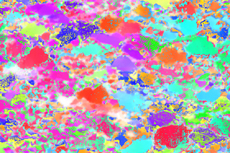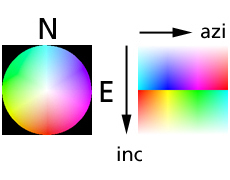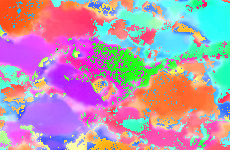1.7
WHAT IS ORIENTATION IMAGING ?
top / contents / section 1 / pages 1.1 -- 1.2 -- 1.3 -- 1.4 -- 1.5 -- 1.6 -- 1.7
Optical orientation imaging



Using CIP (computer-integrated polarization microscopy), a mode of colour-coding can be obtained that is unique with respect to c-axis orientation, i.e., the orientation halfspace. To map the two-dimensional orientation space, i.e., to uniquely colour-code c-axis orientations, azimuth and inclination images are calculated and treated as two channels of a colour image. Two-dimensional colour look-up tables (CLUTs) are used to assign unique colours to any given pixel depending on the azimuth and inclination values of the c-axis at that point.
The chipmunk is purple with green spots on its back. Both colours confirm a NW-SE strike (compare "analogue orientation imaging"). Obviously, the orientation of its c-axis varies gradually from dipping above the plane of the section to dipping below it. Due to the way in which the CLUT is set up (see left), this results in a strong (and somewhat misleading) colour contrast between inc=90° and inc=91°(dipping above and below the plane of the section respectively).
Left, from top to bottom:
- CIP calculated orientation image of Black Hills quartzite
- stereographic projection and orthogonal representation of standard colour look-up table (CIP-Standard CLUT)
- the purple chipmunk who rolled in peas.